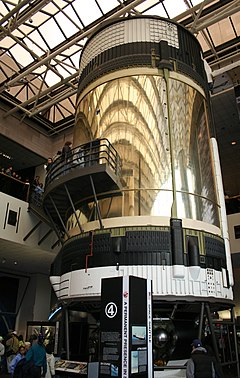Skylab B
This article needs additional citations for verification. (May 2008) |
 Skylab B Orbital Workshop at the National Air and Space Museum | |
| Station statistics | |
|---|---|
| Call sign | Skylab B, International Skylab, Advanced Skylab |
| Crew | 3 |
| Launch | canceled (currently at the National Air and Space Museum in Washington D.C) |
| Mass | 77,088 kg |
| Height | 58 feet 5 inches (17.81 m) |
| Diameter | 21 feet 8 inches (6.60 m) |
| Days occupied | planned 56 to 90 days |
Skylab B was a proposed second US space station similar to Skylab that was planned to be launched by NASA for different purposes, mostly involving the Apollo–Soyuz Test Project, but was canceled due to lack of funding. Two Skylab modules were built in 1970 by McDonnell Douglas for the Skylab program, originally the Apollo Applications Program. The first was launched in 1973 and the other put in storage.
The back-up Skylab (or Skylab B) in storage might have been used to expand the Apollo-Soyuz mission by 56–90 days in 1975.
Potential uses
Some uses considered for the second Skylab module included putting it into a rotation mode where it could generate artificial gravity and a plan to celebrate the 1976 United States Bicentennial with the launch of two Soviet Soyuz missions to the back-up Skylab.[citation needed]
When the Apollo–Soyuz Test Project was created in 1972, NASA had also considered launching the back-up Skylab station during the ASTP mission in 1975, which would involve the Apollo spacecraft docking with the Soyuz spacecraft first, performing intended operations, then heading for the Skylab B, which during the ASTP discussion was originally called the International Skylab, for a 56–90 days extended mission.
For future missions, the station, which would have then been called the Advanced Skylab, could have been expanded by the Space Shuttle, which was due to enter service in 1979. At the time the idea was discussed, NASA still had two Saturn V launchers, three Saturn IB boosters, the back-up Skylab space station, three Apollo CSMs and two Lunar Modules in storage.
However, after the first Skylab was launched in May 1973, the plan for the Skylab B was canceled and the Apollo/Soyuz spacecraft had to use the Docking Module launched on the Apollo-Saturn IB for performing experiments in space. After Project Apollo ended and as NASA was moving to developing the Space Shuttle, the remaining Apollo hardware was donated to museums in 1976.
Possible crew
It was expected at the time by those involved that the initial crew would be the crew which served as backup for Skylab 3 and Skylab 4, and was kept in reserve for the Skylab Rescue mission (minus the science pilot):[1]
| Position | Astronaut | |
|---|---|---|
| Commander | Vance D. Brand | |
| Science Pilot | William Lenoir | |
| Pilot | Don L. Lind | |
Existing hardware
- The unused Skylab B Orbital Workshop (S-IVB 515) is on display at the National Air and Space Museum in Washington D.C. The outer appearance was changed to resemble the flown Skylab station.
-
Skylab B at the National Air and Space Museum
-
The waste management facilities in Skylab B at the National Air and Space Museum.
-
A mannequin astronaut models dining aboard the Skylab B at the Smithsonian NASM.
- An Airlock Module is on display at the Evergreen Aviation & Space Museum.
- One astronaut trainer exists at Space Center Houston and another is at the US Space & Rocket Center.
- A Multiple Docking Adapter is on display at the Kennedy Space Center Visitor Complex.
-
Multiple Docking Adapter at Kennedy Space Center Visitor Complex
References
This article includes a list of general references, but it lacks sufficient corresponding inline citations. (May 2008) |
![]() This article incorporates public domain material from websites or documents of the National Aeronautics and Space Administration.
This article incorporates public domain material from websites or documents of the National Aeronautics and Space Administration.
- ^ Lind, Don L.; Wright, Rebecca (May 27, 2005). Oral History Transcript, Johnson Space Center Oral History Project (PDF). Washington D.C.: NASA. p. 10. Retrieved June 21, 2016.
- Frieling, Thomas J, Quest, "Skylab B: Unflown Missions, Lost Opportunities", 1996, Volume 5, Issue 4, page 12.







